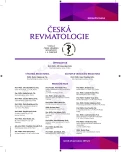Biosimilars – current knowledge on their interchangeability
Authors:
D. Vetchý 1; M. Vetchá 2
Authors‘ workplace:
Ústav technologie léků, Farmaceutická fakulta, Veterinární a farmaceutická univerzita, Brno
1; Lékárna Na Mendlově náměstí, Brno
2
Published in:
Čes. Revmatol., 21, 2013, No. 4, p. 200-205.
Category:
Comments
Overview
The biosimilars cannot be regarded as chemical generics, because, unlike the latter ones, they are not and cannot be chemically identical to the original product. Even seemingly small differences in manufacturing of biosimilars may affect the immunogenic response. To date, there is little known about the mechanism of immunogenic responses. It has been pointed out that the acute therapy may be more immunogenic than the chronic one. Furthermore, experts incline to the belief that the intermittent administration is more likely to cause an immune response than continuous therapy, and that the theory of aggregation and detection of foreign epitopes as the main risk factor for immunogenicity is too simplistic. It is currently not possible to identify a direct safety risk associated with the substitution of biological drugs, because there is very little data dealing with this issue. It has been repeatedly confirmed that biological agents are not simply interchangeable even within the same ATC group due to their indications, side effects, and safety profiles that have been studied in the individual clinical trials designed specifically for every product. The current consensus in some EU countries is to treat the patient with the same agent until the urgent reasons force a change in the treatment.
Key words:
biosimilars, interchangeability of biosimilars, production of biosimilars, registration of biosimilars, immunogenicity
Sources
1. Weise M, Bielsky M-C, De Smet K, et al. Biosimilars: what clinicians should know. Blood 2012; 120 : 5111–7.
2. Scotté F, Launay-Vacher V, Rey JB. Colony stimulating factors (CSF) biosimilars. Progress? Target Oncol 2012;7 Suppl 1: S17–24.
3. Ahmed I, Kaspar B, Sharma U. Biosimilars: impact of biologic product life cycle and European experience on the regulatory trajectory in the United States. Clin Ther 2012; 34 : 400–19.
4. Vetchý D, Vetchá M. Biosimilars – podobné biologické léčivé přípravky. Remedia 2010; 20 : 74–7.
5. Walsh G. Post-translational modifications of protein biopharmaceuticals. Drug Discov Today 2010; 15 : 773–80.
6. Lee JF, Litten JB, Grampp G. Comparability and biosimilarity: considerations for the healthcare provider. Curr Med Res Opin 2012; 28 : 1053–8.
7. European Medicines Agency, Committee for Medicinal Products for Human Use. Guideline on similar biological medicinal products containing monoclonal antibodies – non-clinical and clinical issues. EMA/CHMP/BMWP/403543/2010. Available from: URL: http://www.ema.europa.eu/docs/en_GB/document_library/Scientific_guideline/2012/06/WC500128686.pdf
8. European Medicines Agency, Committee for Medicinal Products for Human Use. Biosimilar Guidelines. Available from: URL: www.ema.europa.eu/ema/index.jsp?curl=pages/regulation/general/general_content_000408.jsp&mid=WC0b01ac058002958c.
9. IV. zimní konference nemocničních lékárníků, Available from: URL: www.zdravky.cz/kongresovy-list/aktualne/iv-zimni-konference-nemocnicnich-lekarniku.
10. Calvo B, Zuñiga L. The US approach to biosimilars: The long-awaited FDA approval pathway. BioDrugs 2012; 26 : 357-61.
11. Scientific Considerations in Demonstrating Biosimilarity to a Reference Product. Available from: URL: http://www.fda.gov/downloads/Drugs/GuidanceComplianceRegulatoryInformation/Guidances/UCM291134.pdf.
12. Chow SC, Yang LY, Starr A, Chiu ST. Statistical methods for assessing interchangeability of biosimilars. Stat Med 2013; 32 : 442–8.
13. Barbosa MD, Kumar S, Loughrey H, Singh SK. Biosimilars and biobetters as tools for understanding and mitigating the immunogenicity of biotherapeutics. Drug Discov Today 2012; 17 : 1282–8.
14. Cohen BA, Oger J, Gagnon A, Giovannoni G. The implications of immunogenicity for protein-based multiple sclerosis therapies. J Neurol Sci 2008; 275 : 7–17.
15. Vulto AG, Crow SA. Risk management of biosimilars in oncology: each medicine is a work in progress. Target Oncol 2012; 7 Suppl 1: S43–9.
16. Abraham I, MacDonald K. Clinical safety of biosimilar recombinant human erythropoietins. Expert Opin Drug Saf 2012; 11 : 819–40.
17. Seidl A, Hainzl O, Richter M, et al. Tungsten-induced denaturation and aggregation of epoetin alfa during primary packaging as a cause of immunogenicity. Pharm Res 2012; 29 : 1454–67.
18. European Medicines Agency. European Assessment Report on Omnitrope. Available from: URL: http://www.ema.europa.eu/docs/en_GB/document_library/EPAR_-_Scientific_Discussion/human/000607/WC500043692.pdf.
19. Simoens S, Verbeken G, Huys I. Biosimilars and market access: a question of comparability and costs? Target Oncol 2012; 7 : 227–31.
20. European Medicines Agency, Committee for Medicinal Products for Human Use. Guideline on immunogenicity assessment of monoclonal antibodies intended for in vivo clinical use. EMA/CHMP/BMWP/86289/2010. Available from: URL: http://www.ema.europa.eu/docs/en_GB/document_library/Scientific_guideline/2012/06/WC500128688.pdf.
21. Ebbers HC, Muenzberg M, Schellekens H. The safety of switching between therapeutic proteins. Expert Opin Biol Ther 2012; 12 : 1473–85.
22. Niederwieser D, Schmitz S. Biosimilar agents in oncology/haematology: from approval to practice. Eur J Haematol 2011; 86 : 277–88.
23. Kalodiki E, Fareed J. New and generic anticoagulants and biosimilars: safety considerations. Clin Appl Thromb Hemost 2011; 17 : 136–9.
24. Lapadula G, Ferraccioli GF. Biosimilars in rheumatology: pharmacological and pharmacoeconomic issues. Clin Exp Rheumatol 2012; 30 (Suppl 73): S102–6.
Labels
Dermatology & STDs Paediatric rheumatology RheumatologyArticle was published in
Czech Rheumatology

2013 Issue 4
Most read in this issue
- Polymyalgia rheumatica – is the biological therapy effective?
- Regulatory T cells as a tool in modulation of immune system
- Biosimilars – current knowledge on their interchangeability
- Circulating Heat Shock Protein 90 (HSP90) in patients with rheumatoid arthritis and axial spondylarthritis
